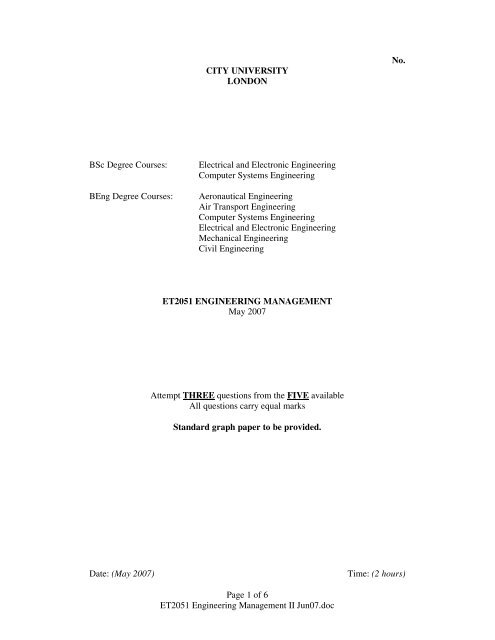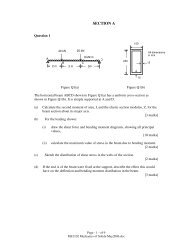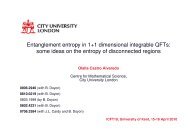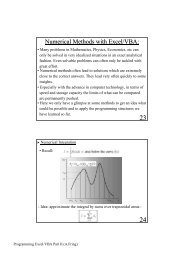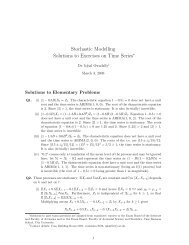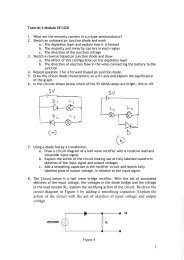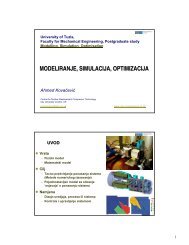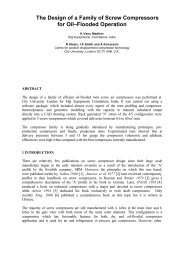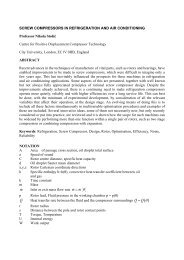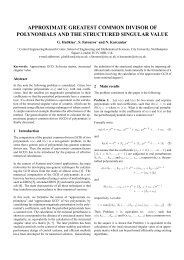ET2051 Engineering Management - Staff.city.ac.uk - City University
ET2051 Engineering Management - Staff.city.ac.uk - City University
ET2051 Engineering Management - Staff.city.ac.uk - City University
You also want an ePaper? Increase the reach of your titles
YUMPU automatically turns print PDFs into web optimized ePapers that Google loves.
CITY UNIVERSITY<br />
LONDON<br />
No.<br />
BSc Degree Courses:<br />
BEng Degree Courses:<br />
Electrical and Electronic <strong>Engineering</strong><br />
Computer Systems <strong>Engineering</strong><br />
Aeronautical <strong>Engineering</strong><br />
Air Transport <strong>Engineering</strong><br />
Computer Systems <strong>Engineering</strong><br />
Electrical and Electronic <strong>Engineering</strong><br />
Mechanical <strong>Engineering</strong><br />
Civil <strong>Engineering</strong><br />
<strong>ET2051</strong> ENGINEERING MANAGEMENT<br />
May 2007<br />
Attempt THREE questions from the FIVE available<br />
All questions carry equal marks<br />
Standard graph paper to be provided.<br />
Date: (May 2007)<br />
Time: (2 hours)<br />
Page 1 of 6<br />
<strong>ET2051</strong> <strong>Engineering</strong> <strong>Management</strong> II Jun07.doc
Question 1.<br />
(a)<br />
(i) Why do large companies often set up a centralised purchasing department<br />
to buy frequently used materials and components, which are then kept in<br />
Stores until the user department requires them. Are there any disadvantages to<br />
this procedure?<br />
[4 marks]<br />
(ii) Stores may charge the user department for the materials and items it holds<br />
in a number of different ways. Name three of these ways and describe the<br />
advantages and disadvantages of e<strong>ac</strong>h.<br />
[6 marks]<br />
(b) The Stores Branch of an engineering firm takes delivery of batches of logic chips,<br />
"logichips", that are to be used in several of the products made by the firm's two<br />
production arms: HomeWare Division (HWD) and F<strong>ac</strong>tory Products Division (FPD).<br />
Delivery occurs over the summer months, and there is a considerable variation in the<br />
price paid by Stores Branch:<br />
1 June: 3000 logichips @ £6.00 e<strong>ac</strong>h<br />
1 July: 4000 @ £4.50 e<strong>ac</strong>h<br />
1 August: 3500 @ 10.00 e<strong>ac</strong>h<br />
1 September: 5000 @ 7.50 e<strong>ac</strong>h<br />
1 October: 3500 @ 8.00 e<strong>ac</strong>h<br />
The company operates a First In First Out policy when charging for Stores'<br />
withdrawals.<br />
FPD withdraws 7500 logichips on 15 September. HWD withdraws 4000 logichips on<br />
21 September.<br />
(i) What is the size of the Stores' inventory of logichips on 2 September?<br />
What is the average cost per logichip to Stores for the units purchased to this<br />
date?<br />
[2 marks]<br />
(ii) What is the cost to FPD of the logichips it withdraws and hence what is the<br />
average cost per logichip to FPD?<br />
[2 marks]<br />
(iii) What is the cost to HWD of the logichips it takes from Stores. What<br />
value does HWD find for the average cost of the logichips it has withdrawn?<br />
[2 marks]<br />
(iv) The manager of HWD complains to the Managing Director for what he<br />
sees as arbitrary discrimination in favour of FPD. What other methods of<br />
charging for Stores' withdrawals could the Managing Director adopt? What<br />
would you recommend?<br />
[4 marks]<br />
Page 2 of 6<br />
<strong>ET2051</strong> <strong>Engineering</strong> <strong>Management</strong> II Jun07.doc
Question 2.<br />
(a) The Maddock Curve for a project is given by:<br />
A<br />
B<br />
wd<br />
c<br />
E<br />
B<br />
r c<br />
= − +<br />
(2.1)<br />
c<br />
E<br />
B<br />
c<br />
Explain e<strong>ac</strong>h of the symbols in equation (2.1) above.<br />
[6 marks]<br />
(b) You have been posted to a new Department and asked to take over responsibility<br />
for managing the ongoing project to build a new small-scale chemical plant. This<br />
£7.5M project was supposed to be complete within 30 months, but that time has just<br />
elapsed and the plant is by no means finished. Your predecessor has spent only<br />
£5.4M so far, and your boss is under the impression that the project is 72% complete;<br />
he is expecting the plant to come in 12 months late but on budget. However, you have<br />
just discovered a project file listing at the end of e<strong>ac</strong>h 6 month period both the <strong>ac</strong>tual<br />
cost of work done to date and the expected cost remaining. These are shown in the<br />
table below.<br />
Months into<br />
project<br />
Actual cost of work done<br />
(£M)<br />
6 1.5 6.15<br />
12 2.55 4.65<br />
18 3.75 4.2<br />
24 4.35 6.0<br />
30 5.4 4.95<br />
Estimated cost remaining<br />
(£M)<br />
In order to show your boss the true state of affairs, you decide to draw the Maddock<br />
Curve for the project, drawing on the ideal curve also for comparison purposes.<br />
(i) Draw such a graph and attempt to explain why the <strong>ac</strong>tual project deviates from the<br />
ideal.<br />
[10 marks]<br />
(ii) State what you think the eventual cost of the project will be, and provide<br />
justification for this estimate. At the current rate of progress, how much longer will it<br />
be before the project is complete?<br />
[4 marks]<br />
Question 3.<br />
(a) (i) Explain the terms, "variable costs" and "fixed costs".<br />
[2 marks]<br />
(ii) Can you give an example of a variable cost for a company running a scheduled<br />
bus service?<br />
[2 marks]<br />
(iii) What is the meaning of the term "total absorption cost"?<br />
[1 mark]<br />
Page 3 of 6<br />
<strong>ET2051</strong> <strong>Engineering</strong> <strong>Management</strong> II Jun07.doc
(b) Julian Carruthers is making cases of Coupled Cutlery, where e<strong>ac</strong>h case contains 12<br />
Knorks, 12 Sporks and 12 Spifes. Material costs are:<br />
• Strip metal @ £35 per case of cutlery<br />
• Lubricants @ £3 for 36 implements<br />
• P<strong>ac</strong>king @ £2 per case.<br />
In addition, part-time labour costs £100 for 10 cases. There are three full-time<br />
workers, who cost the firm £100 a week e<strong>ac</strong>h. Overheads are £200 per week. The<br />
m<strong>ac</strong>hines cost £26,000 and are depreciated over 5 years. Finance has been partly<br />
from Mr Carruthers's own money and partly from a loan of £25,000 at 20% per<br />
annum, repayable in full after 1 year.<br />
(i) List the fixed costs per week and find their total. (Round to nearest £100.)<br />
[4 marks]<br />
(ii) List the variable costs per case and find their total.<br />
[4 marks]<br />
Question 4.<br />
(iii) Draw a graph of total absorption cost versus quantity over the range 5 to<br />
20 cases per week.<br />
[4 marks]<br />
(iv) Julian Carruthers found he could sell 5 cases per week at £200 per case,<br />
and estimated that he could sell 15 cases per week at £150 per case. Use this<br />
information together with your graph under (b)(iii) above to estimate the<br />
profitable range of production.<br />
[3 marks]<br />
(a) (i) If a certain piece of process equipment is designed to carry a throughput, Q<br />
0<br />
,<br />
and has a capital cost, C<br />
0<br />
, write down the general power law expression for the<br />
capital cost, C, of a similar piece of equipment designed for a different throughput, Q.<br />
[3 marks]<br />
(ii) A compressor costing £600,000 has a throughput of 3 m 3 /s. Given that the<br />
exponent in the power law is 0.8, estimate the cost of a compressor of the same<br />
pressure ratio giving a throughput of 4 m 3 /s.<br />
[2 marks]<br />
(b) The table below gives the summary capital costs for a 500 te/day methanol plant,<br />
built on a new, green-field site.<br />
Page 4 of 6<br />
<strong>ET2051</strong> <strong>Engineering</strong> <strong>Management</strong> II Jun07.doc
DIRECT COSTS £M<br />
Chemical re<strong>ac</strong>tor 3<br />
Compressor 5<br />
Circulator 4<br />
Heat exchangers 3<br />
------<br />
Total purchased equipment delivered 15<br />
Plant installation 32<br />
Land 0.90<br />
------<br />
Total direct plant costs 47.9<br />
INDIRECT COSTS<br />
<strong>Engineering</strong> and supervision (here assumed proportional<br />
to cost of total purchased equipment delivered) 4.95<br />
Construction expenses (here assumed proportional to<br />
cost of total purchased equipment delivered) 6.15<br />
TOTAL DIRECT AND INDIRECT PLANT COSTS 59.0<br />
Contr<strong>ac</strong>tor's fee 2.95<br />
Contingency 5.90<br />
TOTAL ERECTED COST 67.85<br />
Table 4(a): Costs for 500 te/day methanol plant<br />
(i) What is a Lang f<strong>ac</strong>tor? Calculate the Lang f<strong>ac</strong>tor for this 500 te/day methanol<br />
plant.<br />
[4 marks]<br />
(ii) Power laws are to be used to estimate the cost of the chemical re<strong>ac</strong>tor, compressor,<br />
circulator and heat exchangers for a 1000 te/day methanol plant. Company records<br />
suggest that the exponents are as shown in Table 4(b)<br />
Plant item<br />
Exponent<br />
Chemical re<strong>ac</strong>tor 0.7<br />
Compressor 0.8<br />
Circulator 0.6<br />
Heat exchangers 0.75<br />
Table 4(b): Exponents for use in power laws for various plant items<br />
Estimate the cost of the chemical re<strong>ac</strong>tor, the compressor, the circulator and the heat<br />
exchangers for the 1,000 te/day methanol plant.<br />
[8 marks]<br />
(iii) Hence estimate the total cost of the 1,000 te/day methanol plant.<br />
[3 marks]<br />
Question 5.<br />
Page 5 of 6<br />
<strong>ET2051</strong> <strong>Engineering</strong> <strong>Management</strong> II Jun07.doc
(a) The engineering profession in the UK was reorganised in January 2002. Explain<br />
its current structure and, briefly, the roles of the constituent bodies. (You may find it<br />
useful to draw an organisation chart here.)<br />
[4 marks]<br />
(b) Name the three categories of engineer recognised in the UK by the <strong>Engineering</strong><br />
Council (UK). Explain the different roles fulfilled by e<strong>ac</strong>h and the qualifications<br />
required for registration in e<strong>ac</strong>h category.<br />
[8 marks]<br />
(c) The UK <strong>Engineering</strong> Institutions emphasise the desirability of their members<br />
having management training and experience in addition to technical skills. Why do<br />
you think this is so?<br />
[8 marks]<br />
Internal Examiner:<br />
Professor P. J. Thomas<br />
Page 6 of 6<br />
<strong>ET2051</strong> <strong>Engineering</strong> <strong>Management</strong> II Jun07.doc


